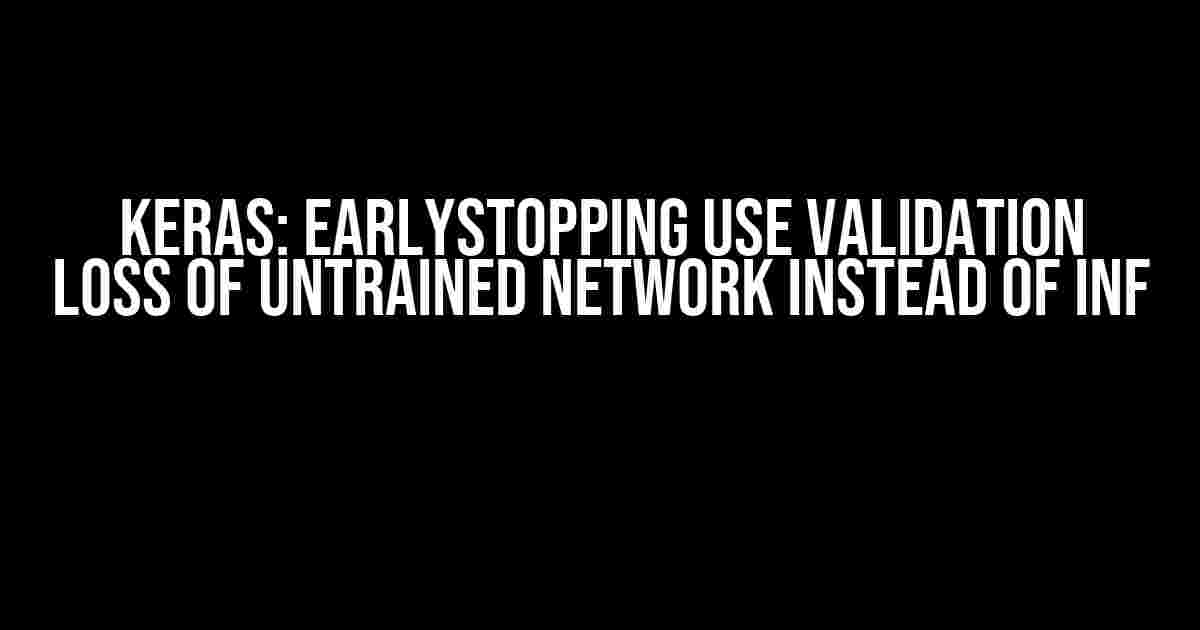Have you ever encountered an issue while working with Keras where the EarlyStopping callback uses the validation loss of an untrained network instead of infinity? This can be frustrating, especially when you’re trying to implement early stopping to avoid overfitting in your neural network. In this article, we’ll dive into the reasons behind this issue and explore solutions to overcome it.
The Problem: EarlyStopping Uses Validation Loss of Untrained Network
When you implement early stopping in Keras, the Primary purpose is to stop training when the model’s performance on the validation set starts to degrade. However, in some cases, the EarlyStopping callback might use the validation loss of an untrained network instead of infinity. This can cause the training process to terminate prematurely, leading to suboptimal results.
Why Does This Happen?
There are a few reasons why EarlyStopping might use the validation loss of an untrained network:
-
The network is not trained at all, or it’s not trained enough, resulting in a validation loss that’s not representative of the model’s actual performance.
-
The validation dataset is too small, causing the model to overfit to the validation set, which leads to an incorrect estimation of the validation loss.
-
The model is not initialized properly, resulting in an incorrect validation loss calculation.
Solutions to Overcome the Issue
Don’t worry; there are several ways to overcome this issue and ensure that EarlyStopping uses the correct validation loss:
1. Initialize the Model Properly
Make sure to initialize your model correctly before training. This includes setting the correct loss function, optimizer, and metrics. Here’s an example:
from keras.models import Sequential
from keras.layers import Dense
model = Sequential()
model.add(Dense(64, activation='relu', input_shape=(10,)))
model.add(Dense(64, activation='relu'))
model.add(Dense(1, activation='sigmoid'))
model.compile(loss='binary_crossentropy', optimizer='adam', metrics=['accuracy'])
2. Train the Model for a Few Epochs Before Implementing EarlyStopping
One solution is to train the model for a few epochs before implementing EarlyStopping. This allows the model to learn something meaningful about the data before the callback kicks in:
from keras.callbacks import EarlyStopping
# Train the model for 5 epochs before implementing EarlyStopping
model.fit(X_train, y_train, epochs=5, verbose=0)
early_stopping = EarlyStopping(monitor='val_loss', patience=5, min_delta=0.001)
model.fit(X_train, y_train, epochs=50, validation_data=(X_val, y_val), callbacks=[early_stopping], verbose=0)
3. Use a Custom EarlyStopping Callback
You can create a custom EarlyStopping callback that checks if the model is trained before calculating the validation loss. Here’s an example:
from keras.callbacks import Callback
class CustomEarlyStopping(Callback):
def __init__(self, monitor='val_loss', patience=0, min_delta=0, verbose=0, mode='auto'):
super(CustomEarlyStopping, self).__init__()
self.monitor = monitor
self.patience = patience
self.verbose = verbose
self.min_delta = min_delta
self.wait = 0
self.stopped_epoch = 0
self.mode = mode
def on_train_begin(self, logs=None):
self.wait = 0
self.stopped_epoch = 0
def on_epoch_end(self, epoch, logs=None):
current = logs.get(self.monitor)
if current is None:
warnings.warn('Early stopping requires %s available!' % self.monitor, RuntimeWarning)
if self.mode == 'min':
if current - self.min_delta < self.best:
self.best = current
self.wait = 0
elif current + self.min_delta > self.best:
self.wait += 1
if self.wait >= self.patience:
self.stopped_epoch = epoch
self.model.stop_training = True
else:
if current - self.min_delta > self.best:
self.best = current
self.wait = 0
elif current + self.min_delta < self.best:
self.wait += 1
if self.wait >= self.patience:
self.stopped_epoch = epoch
self.model.stop_training = True
def on_train_end(self, logs=None):
if self.stopped_epoch > 0:
print('Epoch %05d: early stopping' % (self.stopped_epoch + 1))
custom_early_stopping = CustomEarlyStopping(monitor='val_loss', patience=5, min_delta=0.001)
model.fit(X_train, y_train, epochs=50, validation_data=(X_val, y_val), callbacks=[custom_early_stopping], verbose=0)
4. Increase the Validation Set Size
Another solution is to increase the size of the validation set. This helps to reduce overfitting to the validation set and provides a more accurate estimation of the validation loss:
from sklearn.model_selection import train_test_split
X_train, X_val, y_train, y_val = train_test_split(X, y, test_size=0.2, random_state=42)
Conclusion
In this article, we’ve explored the issue of EarlyStopping using the validation loss of an untrained network instead of infinity in Keras. We’ve also discussed four solutions to overcome this issue: initializing the model properly, training the model for a few epochs before implementing EarlyStopping, using a custom EarlyStopping callback, and increasing the validation set size.
| Solution | Advantages | Disadvantages |
|---|---|---|
| Initialize the model properly | Easy to implement, improves model performance | May not solve the issue in all cases |
| Train the model for a few epochs before implementing EarlyStopping | Simple to implement, allows the model to learn something meaningful about the data | May not work well with complex models or large datasets |
| Use a custom EarlyStopping callback | Flexible, allows for customization, solves the issue in most cases | Requires more code, may be complex to implement for beginners |
| Increase the validation set size | Improves the accuracy of the validation loss estimation, reduces overfitting | May require more computational resources, increases training time |
Remember to choose the solution that best fits your specific use case. Happy training!
FAQs
Q: What if I’m using a pre-trained model?
A: If you’re using a pre-trained model, you can skip the model initialization step and proceed with implementing EarlyStopping.
Q: Can I use EarlyStopping with other optimizers?
A: Yes, EarlyStopping can be used with other optimizers, such as RMSprop, Adagrad, or Adadelta.
Q: How do I tune the patience parameter in EarlyStopping?
A: The patience parameter should be set based on the complexity of your model and the dataset. A larger patience value will allow the model to train for more epochs before stopping, while a smaller value will cause the training to stop earlier.
Q: Can I use EarlyStopping with other callbacks?
A: Yes, EarlyStopping can be used in combination with other callbacks, such as ModelCheckpoint or ReduceLROnPlateau.
By following the solutions outlined in this article, you should be able to overcome the issue of EarlyStopping using the validation loss of an untrained network instead of infinity in Keras. Happy training!
Frequently Asked Question
Keras’ EarlyStopping can be a bit finicky – let’s get to the bottom of its mysteries!
Why does EarlyStopping use the validation loss of the untrained network instead of Infinity?
This is a known bug in Keras, and it’s been reported multiple times. Essentially, when the `EarlyStopping` callback is initialized, it sets the `best` attribute to the validation loss of the untrained network, which is usually a very large value. This is because the network hasn’t been trained yet, so its performance is terrible. However, this value should be set to Infinity, not the validation loss of the untrained network. This bug is being worked on, but for now, you can just set the `min_delta` parameter to a large value, like 100000, to avoid this issue.
How can I avoid this issue in my code?
To avoid this issue, you can set the `min_delta` parameter of the `EarlyStopping` callback to a large value, like 100000. This will ensure that the `best` attribute is set to Infinity, rather than the validation loss of the untrained network. Additionally, you can also set the `patience` parameter to a large value to avoid stopping too early.
Is this issue limited to the EarlyStopping callback?
No, this issue is not limited to the EarlyStopping callback. It can also affect other callbacks, such as ModelCheckpoint, that rely on the validation loss. However, the impact of this issue is more pronounced in EarlyStopping, since it’s designed to stop training when the validation loss stops improving.
Are there any alternative solutions to EarlyStopping?
Yes, there are alternative solutions to EarlyStopping. One approach is to implement your own custom callback that tracks the validation loss and stops training when it plateaus. Another approach is to use a separate library, such as TensorFlow’s built-in `tf.keras.callbacks.EarlyStopping` implementation, which doesn’t have this issue.
Will this issue be fixed in future versions of Keras?
Yes, the Keras team is aware of this issue and is working on a fix. In fact, there’s already a pull request that addresses this issue, so it’s likely to be fixed in a future version of Keras. Until then, you can use the workarounds mentioned above to avoid this issue.


